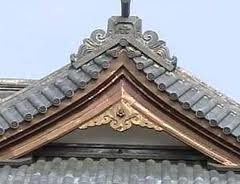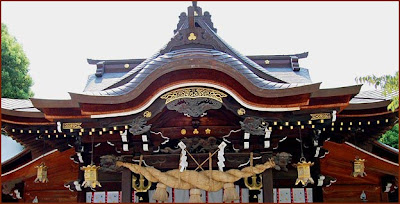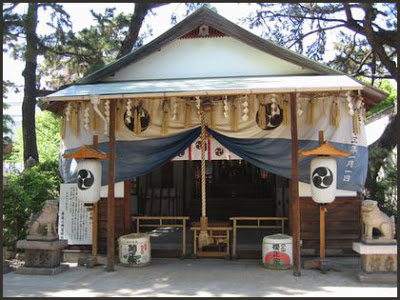[ . BACK to DARUMA MUSEUM TOP . ]
:::::::::::::::::::::::::::::::::::::::::::::::::::::::::::::::::::::::::::::::::::::::::::::::::::::
Kinoshita Choshoshi 木下長嘯子 / 長嘯
Kinoshita Chooshooshi
(1569 - 1649)
![]()
from 圓徳院
quote
Seiryu-En . . . the place where long ago Kinoshita Choshoshi had his retreat.
A Momoyama waka poet, Kinoshita Choshoshi was the nephew-in-law of Toyotomi Hideyoshi and had exchanges with Confucianist Hayashi Razan, devotees of the way of tea, tea master and garden architect Kobori Enshu, as well as with many nobles of the court.
He studied waka poetry with Hosokawa Yusai, an initiate of the traditions of the Kokinshu collection of 'ancient and modern' poems.
From the early modern age to more recent times this has been the stage for such activities as the creation of paintings and literary works, or tea gatherings, and many writers and artists have gathered here.
source : www.seiryu-en.com
:::::::::::::::::::::::::::::::::::::::::::::::::::::::::::::::::::::::::::::::::::::::::::::::::::::
![]()
Ehon mushi erami 画本虫撰
Picture Book: Selected Insects
quote
On this, the night of the fourteenth of the eighth month, the usual group of comic poets dragged one another along to listen to the voices of the insects that chirp in the fields. North from Ryogoku and east of Yoshiwara, we spread out our rugs on the embankment of the Sumida River near Iosaki, where they sell carp [and love], and tried to fix a value on the voice of each insect, high or low.
By force of circumstance we forwent wine and women, and so any females in the parties nearby must have said that we were a group of stingy worms. Intoned prayers from a nearby temple mingled faintly with the sounds of the insects, reminding us sadly of that worship hall for the princess built by Kuenshi.
We thought that it would be simply inexcusable for people to accuse us of selling old leftovers at the morning market and so, hot on the heels of the
'Poetry Contest on Various Insects'
compiled by Kinoshita Choshoshi,
we have composed playful poems on the sentiments of love. Thus we wiled away the night. Since river and mountain, wind and moon have no habitual master, there was no landlord pressing for the rent. And since there was no reception room on our grassy mat, we decided that the [singing] insects must be the true owners. Turning to face these dew-covered personages, we politely bow down low and can't stand up!
[The meaning of the last sentence is unclear.]
source : www.britishmuseum.org
:::::::::::::::::::::::::::::::::::::::::::::::::::::::::::::::::::::::::::::::::::::::::::::::::::::
. Toyotomi Hideyoshi Kinoshita 豊臣秀吉 .
Choshoshi KINOSHITA, and was a man of literature who absorbed the works of FUJIWARA no Teika.
- Reference -
:::::::::::::::::::::::::::::::::::::::::::::::::::::::::::::::::::::::::::::::::::::::::::::::::::::
H A I K U
長嘯の墓もめぐるか鉢叩き
Chooshoo no haka mo meguru ka hachitakaki
. Matsuo Basho 松尾芭蕉 .
Written on the 24th day of the 12th lunar month, 1689 元禄2年
Basho had visited Kyorai to see the procession of the monks.
They do it for 48 days, starting on the 13th day of the 11th lunar month.
are they also walking around
the grave of Choshoshi ?
Hachitataki ceremony
Tr. Gabi Greve
. Hachi Tataki, hachitataki 鉢叩 鉢敲, 鉢扣
First yearly Memorial Service for Kuuya Shoonin .
kigo for the New Year
![]()
source : itoyo/basho
are they ranged around
Choshoshi’s grave?
bowl-slapping bretheren
Tr. Robin D. Gill
Have his rounds taken him
as far as Chooshoo's tomb? --
priest seeking alms.
Tr. Reichhold
.............................................................................
a waka by Choshoshi
鉢叩き暁方の一声は冬の夜さへも鳴く郭公
hachitataki akegata no hitokoe wa
fuyo no sae mo naku hototogisu
itinerant priest
your lone voice toward dawn -
a hotogisu
that sings
even on a winter's night
Tr. Cheryl A. Crowley
.............................................................................
![]()
世々の人の月はながめしかたみぞと
おもへばおもへぬるゝ袖かな
source : www.city.himeji.lg.jp
:::::::::::::::::::::::::::::::::::::::::::::::::::::::::::::::::::::::::::::::::::::::::::::::::::::
. Matsuo Basho 松尾芭蕉 - Archives of the WKD .
[ . BACK to WORLDKIGO TOP . ]
[ . BACK to DARUMA MUSEUM TOP . ]
:::::::::::::::::::::::::::::::::::::::::::::::::::::::::::::::::::::::::::::::::::::::::::::::::::::
:::::::::::::::::::::::::::::::::::::::::::::::::::::::::::::::::::::::::::::::::::::::::::::::::::::
Kinoshita Choshoshi 木下長嘯子 / 長嘯
Kinoshita Chooshooshi
(1569 - 1649)

from 圓徳院
quote
Seiryu-En . . . the place where long ago Kinoshita Choshoshi had his retreat.
A Momoyama waka poet, Kinoshita Choshoshi was the nephew-in-law of Toyotomi Hideyoshi and had exchanges with Confucianist Hayashi Razan, devotees of the way of tea, tea master and garden architect Kobori Enshu, as well as with many nobles of the court.
He studied waka poetry with Hosokawa Yusai, an initiate of the traditions of the Kokinshu collection of 'ancient and modern' poems.
From the early modern age to more recent times this has been the stage for such activities as the creation of paintings and literary works, or tea gatherings, and many writers and artists have gathered here.
source : www.seiryu-en.com
:::::::::::::::::::::::::::::::::::::::::::::::::::::::::::::::::::::::::::::::::::::::::::::::::::::

Ehon mushi erami 画本虫撰
Picture Book: Selected Insects
quote
On this, the night of the fourteenth of the eighth month, the usual group of comic poets dragged one another along to listen to the voices of the insects that chirp in the fields. North from Ryogoku and east of Yoshiwara, we spread out our rugs on the embankment of the Sumida River near Iosaki, where they sell carp [and love], and tried to fix a value on the voice of each insect, high or low.
By force of circumstance we forwent wine and women, and so any females in the parties nearby must have said that we were a group of stingy worms. Intoned prayers from a nearby temple mingled faintly with the sounds of the insects, reminding us sadly of that worship hall for the princess built by Kuenshi.
We thought that it would be simply inexcusable for people to accuse us of selling old leftovers at the morning market and so, hot on the heels of the
'Poetry Contest on Various Insects'
compiled by Kinoshita Choshoshi,
we have composed playful poems on the sentiments of love. Thus we wiled away the night. Since river and mountain, wind and moon have no habitual master, there was no landlord pressing for the rent. And since there was no reception room on our grassy mat, we decided that the [singing] insects must be the true owners. Turning to face these dew-covered personages, we politely bow down low and can't stand up!
[The meaning of the last sentence is unclear.]
source : www.britishmuseum.org
:::::::::::::::::::::::::::::::::::::::::::::::::::::::::::::::::::::::::::::::::::::::::::::::::::::
. Toyotomi Hideyoshi Kinoshita 豊臣秀吉 .
Choshoshi KINOSHITA, and was a man of literature who absorbed the works of FUJIWARA no Teika.
- Reference -
:::::::::::::::::::::::::::::::::::::::::::::::::::::::::::::::::::::::::::::::::::::::::::::::::::::
H A I K U
長嘯の墓もめぐるか鉢叩き
Chooshoo no haka mo meguru ka hachitakaki
. Matsuo Basho 松尾芭蕉 .
Written on the 24th day of the 12th lunar month, 1689 元禄2年
Basho had visited Kyorai to see the procession of the monks.
They do it for 48 days, starting on the 13th day of the 11th lunar month.
are they also walking around
the grave of Choshoshi ?
Hachitataki ceremony
Tr. Gabi Greve
. Hachi Tataki, hachitataki 鉢叩 鉢敲, 鉢扣
First yearly Memorial Service for Kuuya Shoonin .
kigo for the New Year

source : itoyo/basho
are they ranged around
Choshoshi’s grave?
bowl-slapping bretheren
Tr. Robin D. Gill
Have his rounds taken him
as far as Chooshoo's tomb? --
priest seeking alms.
Tr. Reichhold
.............................................................................
a waka by Choshoshi
鉢叩き暁方の一声は冬の夜さへも鳴く郭公
hachitataki akegata no hitokoe wa
fuyo no sae mo naku hototogisu
itinerant priest
your lone voice toward dawn -
a hotogisu
that sings
even on a winter's night
Tr. Cheryl A. Crowley
.............................................................................

世々の人の月はながめしかたみぞと
おもへばおもへぬるゝ袖かな
source : www.city.himeji.lg.jp
:::::::::::::::::::::::::::::::::::::::::::::::::::::::::::::::::::::::::::::::::::::::::::::::::::::
. Matsuo Basho 松尾芭蕉 - Archives of the WKD .
[ . BACK to WORLDKIGO TOP . ]
[ . BACK to DARUMA MUSEUM TOP . ]
:::::::::::::::::::::::::::::::::::::::::::::::::::::::::::::::::::::::::::::::::::::::::::::::::::::


























































